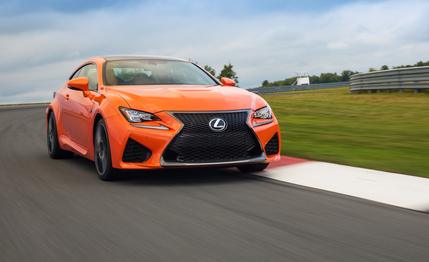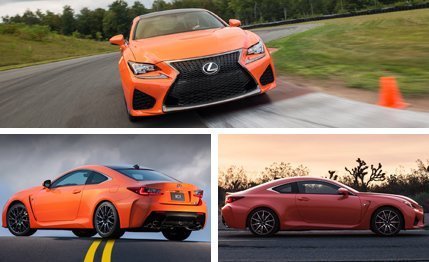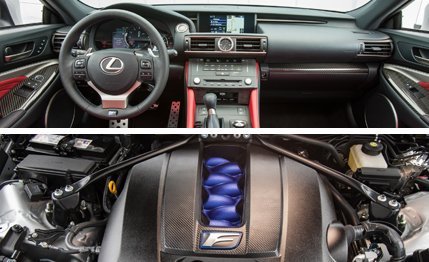 First Drive Review
First Drive Review
In a market thick with sedans and crossovers and SUVs, two-door coupes are few and far between. Which is why we were a little surprised—pleasantly so—when we learned that Lexus would launch the high-performance, rear-wheel-drive RC F coupe into an ever-shrinking market space dominated by the Germans.
The RC chassis is a Frankenstein mash-up of three different cars. From the front bumper to the A-pillars lay the bones of the Lexus GS sedan. Between the A- and C-pillars, engineers borrowed the floorpan of the Lexus IS C convertible (reinforcing the sills for good measure). The rear end is adapted from the current Lexus IS sedan. The three sections are welded and bonded together with structural adhesive used around the rockers, inner fenders, A-pillars, and floor crossmember. Extra spot welds join the cowl and rockers, and laser screw welding is used for the door apertures, rear window, and package tray. Structurally, the regular-strength RC coupe and the hot-rodded RC F are nearly identical, although the F has its own fenders, aluminum hood, and front bumper cover, as well as a few more braces to stiffen things up even more.
Sliding into the big-bolstered buckets reveals a snug cockpit with a high center console running down the center of the car. The bezel-shifting LCD gauge pod from the IS350 F Sport changes its appearance among the four available drive modes (Eco, Normal, Sport, Sport+). Gone is the IS’s goofy mouse controller, replaced by a simple rotary-knob control for the radio, unless you pony up for the navigation system, in which case a haptic touchpad controls the infotainment screen. Audi’s MMI may be our preferred interface, but the Lexus system has just the right amount of redundancy and allows any first-time driver to tune the radio or set the HVAC temp without taking a Berlitz course.

Any successful coupe story blends show with the go, and there’s no denying that the RC is flashy. In F form, the RC350’s “fauxtarossa” slats at the rear disappear, and bargeboard-like vents, carried over from the IS F, cool the engine compartment. The F can look busy from some angles, as if there was one designer responsible for the car’s tail, another assigned to the hood, and still another working on the side, with each one trying to put their stamp on it. This polarizes some onlookers, but once you step back and view the whole, the RC F looks more cohesive.
Compared to the IS350 sedan, the RC F is 1.5 inches longer overall, 1.6 inches lower, and 1.3 inches wider with a 2.7-inch-shorter wheelbase. That last measurement takes its toll. Rear-seat passengers will miss headroom, legroom, and any other room you can think of. It’s tight back there, but, hey, it’s a coupe—Lexus is confident the RC’s curb appeal will outweigh any deficits of practicality.
There are very few moments in life when we’d say 467 horsepower isn’t enough—but this is one of them. While the outgoing IS F’s 5.0-liter V-8 was thoroughly overhauled for the new RC F, the car also gained a good bit of weight, and the RC feels no quicker than the IS. Dripping wet, this car breaches the two-ton mark, some 200 pounds heavier than the IS F, and the mass will only increase with optional add-ons. We’re not expecting the RC to outpace the old IS, either. Lexus’s 4.4-second zero-to-60-mph estimate is just about what we would predict (which is what we got out of some IS Fs we previously tested). We’ll have an RC F to test soon, so stand by.

To Lexus’s credit, adding 51 horsepower to the V-8 wasn’t a simple ECU reflash. Titanium valves (all 32 of them) and a lighter crankshaft and connecting rods allowed engineers to stretch the redline from 6800 rpm to 7300. More revs equals more power, but they also require more air and more fuel, thus the F’s tweaked 2UR-GSE V-8 requires both a larger throttle body and fuel injectors. Maximum power comes at a heady 7100 rpm, while the torque peak of 389 lb-ft, up 18 from the IS F, is available at a more accessible 4800 rpm, 400 lower than the old engine’s peak. The compression ratio also increases to 12.3:1 from 11.8:1.
Subsidizing the extra power are wider-range camshaft phasers, giving the new engine Atkinson-cycle capability. This improves efficiency while cruising and under low loads, no doubt a factor in helping the RC F net a 25-mpg EPA highway-mileage estimate. In fact, cruising in top gear at highway speeds under light throttle is quite serene.